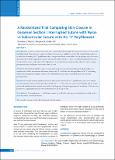Please use this identifier to cite or link to this item:
https://hdl.handle.net/20.500.14356/1867| Title: | A Randomized Trial Comparing Skin Closure in Cesarean Section: Interrupted Suture with Nylon vs Subcuticular Suture with No ‘1’ Polyfilament |
| Authors: | Shrestha, A Napit, J Neupane, B Sedhai, L B |
| Citation: | ShresthaA., NapitJ., NeupaneB., & SedhaiL. B. (2014). A Randomized Trial Comparing Skin Closure in Cesarean Section: Interrupted Suture with Nylon vs Subcuticular Suture with No ‘1’ Polyfilament. Journal of Nepal Health Research Council. https://doi.org/10.33314/jnhrc.v0i0.397 |
| Issue Date: | 2013 |
| Publisher: | Nepal Health Research Council |
| Article Type: | Original Article |
| Keywords: | Cesarean section Skin closure Subcuticular sutures |
| Series/Report no.: | Sep-Dec, 2013;397 |
| Abstract: | Abstract Background: Cesarean section is one of the most commonly performed operations in most countries of the world including Nepal. Hence there is a load on the financial resources of healthcare system. The rational of this study was to utilize the remaining No ‘1’ polyfilament after closing rectus sheath to stitch skin. So, the primary objective was to determine the wound complication rates for subcuticular suture with No’1’ petcryl (polyfilamentpolyglycolic acid) Vs intermittent suture with nylon 2-0 for skin closure at cesarean delivery and secondary objective was to compare postoperative pain and patient satisfaction about the scar. Methods: One hundred and thirty eight women undergoing cesarean section at Chitwan Medical College was randomized to either intermittent skin suture with nylon 2-0 or subcuticular with polyfilament No ‘1’ (remaining suture after closing rectus sheath). Evidence of wound infection, pain and overall satisfaction were assessed postoperatively. Results: The overall wound complications rate in subcuticular stitch with No’1’ polyfilament suture were similar as in intermittent mattress stitch with nylon 2-0 (15.9% vs. 14.49%). Pain on postoperative third day and six weeks and overall satisfaction about wound were similar in both groups. Only prolong rupture of membrane >18 hours was found to be a significant risk factor of wound infection (OR: 3.4; p=0.04).Conclusions: The remaining no ‘1’ polyfilament suture (petcryl) after suturing rectus sheath can be safely used to close skin suture in cesarean section. Keywords: cesarean section; skin closure; subcuticular sutures. |
| Description: | Original Article |
| URI: | http://103.69.126.140:8080/handle/20.500.14356/1867 |
| ISSN: | Print ISSN: 1727-5482; Online ISSN: 1999-6217 |
| Appears in Collections: | Vol. 11 No. 3 Issue 25 Sep - Dec, 2013 |
Files in This Item:
| File | Description | Size | Format | |
|---|---|---|---|---|
| 397-Article Text-480-1-10-20140207.pdf | Fulltext Download | 262.19 kB | Adobe PDF |  View/Open |
Items in DSpace are protected by copyright, with all rights reserved, unless otherwise indicated.
